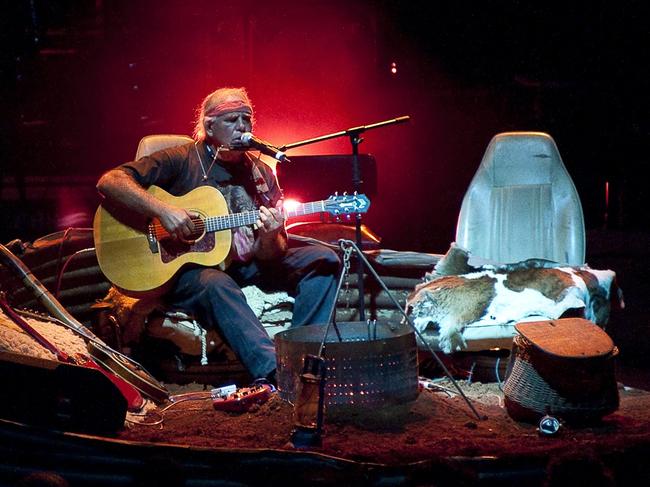Playlist from Brisbane that rocked our world
High Rotation looks back at three decades of Brisbane’s music scene.

When Bernard Fanning’s mum bought a bright red Maton guitar for her son at a garage sale in the Brisbane suburb of Bardon, she ever-so-slightly changed the course of Australian music history. That used instrument — which she snagged for $15 — was heard in the triple-guitar attack of Powderfinger’s breakthrough single, 1996’s Pick You Up, in whose music video it also appeared.
The singer-songwriter has continued recording and performing with that red Maton during the past two decades, but right now it’s having a rest inside a glass case in the middle of the city. It is one of many artefacts housed within High Rotation, a Museum of Brisbane exhibition that celebrates the past 30 years of creative expression to have emerged from the Queensland capital.
A few steps away, in the centre of the room, is a more contemporary totem associated with Kate Miller-Heidke, the pop artist who represented Australia at the Eurovision Song Contest final in May.

On display is the sparkling dress and headpiece, designed by Gwendolynne Burkin, that were seen by millions of viewers as the Brisbane-raised singer swayed on a bendy pole to her earworm tune Zero Gravity.
As you enter the large room that houses High Rotation, the first item to be seen is a vintage maroon instrument given by Kym Bradshaw of local punk rock band the Saints, whose song (I’m) Stranded became a do-it-yourself global hit in 1976 despite the lack of industry infrastructure in its sleepy home town.
And when you step out into the main space, your eye clocks several large screens and sets of headphones hanging from the ceiling, where curated playlists of music videos play on loop. On one screen, the dramatic alternative metal of the Butterfly Effect’s Phoenix follows the gorgeous male/female vocals of mid-2000s indie pop band Iron On’s Learn Today, Earn Tomorrow; on another, alternative rock trio Screamfeeder showcases its own memorable vocal interplay between scene stalwarts Kellie Lloyd and Tim Steward with the classic 1998 single Hi Cs.
There’s comedy in some of the juxtapositions here, such as when the acoustic melancholy of Pete Murray’s 2004 hit single So Beautiful is followed by the degenerate rock of Loose Cannons by indie band HITS — the opening bars feature distorted guitars and a sighed expletive, while in the video an out-of-shape bloke jogs around the inner-city suburbs of West End and Highgate Hill between pauses to puff on cigarettes and scoff burgers.
Any of these videos can be called up at any time on YouTube, but the beauty of a thoughtfully curated exhibition is to create connections in the visitor’s mind that may not have existed.
As well, it’s worth noting that many of the musicians who appear in these videos still call Brisbane home, which speaks to the city’s ongoing strength as a creative hub and an attractive place to put down roots.
There’s one ARIA award on display — Lachlan “Magoo” Gould’s pointy statue for producer of the year in 1998, for his work on Regurgitator’s genre-hopping second album Unit; one smashed guitar courtesy of hard rock band Violent Soho; one pretty, flamingo-like stage costume provided by Patience Hodgson of indie rock trio the Grates; and a plaque for pop band Sheppard, whose platinum-selling 2014 single Geronimo was the first ARIA No 1 song recorded in Brisbane.
Situated near Fanning’s red Maton is perhaps the most mind-boggling artefact in the entire exhibition. In 1993, Daniel Jones and Darren Hayes met through an ad placed in former local street press Time Off. They formed a pop duo named Savage Garden and soon found extraordinary success. A framed display denotes Savage Garden’s 10 million worldwide sales of its 1997 self-titled debut album, with 32 national flags inscribed around its edges showing the various territories where the Brisbane pair achieved gold or platinum accreditations.
What has been described here, however, is only scratching the surface of a true cultural treasure trove. This is a must-see experience for anyone with even a passing interest in Australian popular music, and after nearly two hours well spent, I head for the exit.
But it’s here that I get a little emotional, for this long hallway becomes a mirror that reflects my young adulthood back at me. The first week that I moved to Brisbane in 2006, I saw two shows at The Zoo after recently turning 18. What I heard in that room — and in others like it across the city in the 13 years since — gave me some of the greatest nights of my life, having spent thousands of hours at these venues, facing the stage, immersed in sound.

Sometimes it’s easy to take that sort of sustained lifestyle decision for granted, especially as someone now professionally connected to this business. But while taking in the hundreds of carefully chosen live performance images that appear here, such as singer-songwriting legend Kev Carmody, the cumulative effect is a powerful reminder that music is the stuff of life itself; as essential as food, drink and love.
While this artfully curated exhibition manages to capture the past three decades of Brisbane’s music culture, it’s fitting that this story ends with an ellipsis rather than a full stop, for it opened just days before a fresh influx of artists, industry professionals and music fans converges on the city for Bigsound, the annual conference and festival that excels at both listening to wise old heads and shining a light on the stars of tomorrow.
High Rotation is open daily from 10am to 5pm and on Fridays from 10am to 7pm at the Museum of Brisbane, until April 19 next year.




To join the conversation, please log in. Don't have an account? Register
Join the conversation, you are commenting as Logout